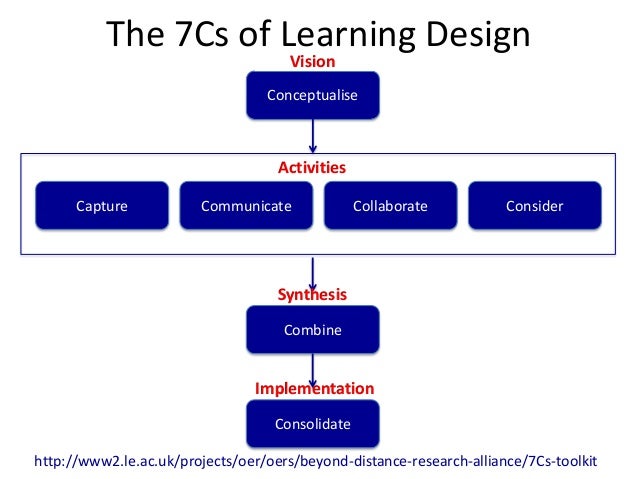Jonassen’s (2000) quote resonated with me, “[S]tudents learn from thinking in meaningful ways. Thinking is engaged by activities, which can be fostered by computers or teachers.” The ideal technology-enhanced learning experience (TELE) in a math or science class would incorporate collaborative group work with the use of digital technology, using the 7Cs of Learning Design.
One of the key challenges facing educators today, is designing for learning. Conole (2014) has outlined the development and evaluation of a framework for learning design titled, The 7Cs of Learning Design. They consist of: conceptualize, capture, create, communicate, collaboration, consider and consolidate. The idea is, for teachers to you use this framework while designing learning experiences to create more engaging learning interventions for their students.

Conole, G. (2014). The 7Cs of Learning Design—A new approach to rethinking design practice. In Proceedings of the 9th International Conference on Networked Learning (pp. 502-509).
Jonassen, D. H. (2000). Computers as mindtools for schools, 2nd Ed. Upper Saddle River, NJ: Merrill/ Prentice Hall. Retrieved from Google Scholar: http://scholar.google.com/scholar?q=Jonassen+mindtools&ie=UTF-8&oe=UTF-8&hl=en&btnG=Search
I haven’t encountered these 7C’s but thanks Sean for sharing! While the model demonstrates a linear progression from Vision to Implementation, do you feel the process should be more cyclical? As well, do you feel educators are limited by conforming to prescribed objectives over learner inquiry?
Andrew
Hi Andrew,
I agree that the process of design should be more cyclical. Our natural way of thinking is more cyclical than linear. What I like about the 7Cs, is that it gives us designers a starting off point. By no means do educators have to go in this particular order, but I believe by encompassing all of the 7Cs, students will benefit from this design cycle.
I have never encountered this one either. But looking at it, I think it could be used for students as well. When they are creating a project or assignment. What do you think?
Thanks for sharing 7C’s framework. I can see each stage can be enhanced by current technology like social media, wiki and google docs. The framework could be helpful in the design/implementation phase of large-scale STEM classes for the enriched learning experience.
I like the fact that you brought up “collaborative group work…”
I wonder if group work hinders those students who do not wish to work in groups or put into groups that are not conducive for the student.
A good next step might be to explain the 7Cs of Learning Design with a real life example.
Please include the “Jonassen?s (2000)” in your reference list.
Christopher
I wonder too about the group work aspect in the 7C design model. With the way the new BC curriculum is heading, it’s all about collaborative group work and inquiry so I believe this fits in nicely with the 7C model. Students may be hesitant when it comes to working in groups, but they need to learn how to work together in the real world.